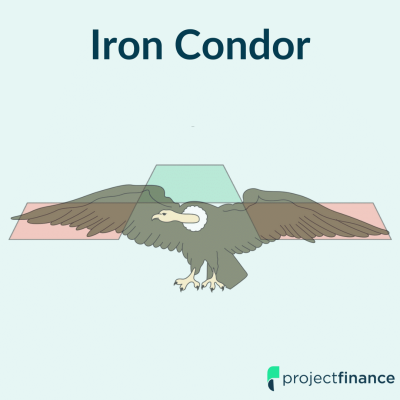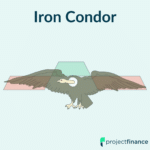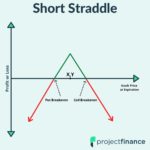Last updated on February 10th, 2022 , 12:49 pm

The Iron Condor is one of the most popular options trading strategies, especially among income traders who prefer to have limited risk and a high probability of making money each month.
Here’s what you’ll learn in this guide:
✓ How Iron Condors are set up and how they profit (when buying or selling them).
✓ The historical profit/loss statistics for over 70,000 iron condor trades.
✓ Ways to adjust an iron condor when the stock price has moved against you.
Ready? Let’s get started.
Jump To
The Long Iron Condor Options Strategy
Like all options strategies, the position can either be bought or sold. When you buy an iron condor, your position is called a “long Iron Condor.”
The long Iron Condor is set up by simultaneously:
➜ Buying an out-of-the-money Call Spread
➜ Buying an out-of-the-money Put Spread
The long Iron Condor is a limited-risk position that profits when the stock price makes a big move in either direction.
Conversely, the trade loses money when the stock price remains in-between the two spreads as time passes (no big movement in either direction).
Now that you know how the long Iron Condor strategy works, let’s talk about the more popular strategy of selling Iron Condors.
The Short Iron Condor Options Strategy
When an Iron Condor is sold, the position is called a “short Iron Condor.”
Traders with the goal of extracting monthly income from the markets love selling Iron Condors because they can make money when the market remains in a range, but have limited loss potential if the market makes a big move in either direction.
The Short Iron Condor is constructed by simultaneously:
All options need to be in the same expiration cycle. As long as the stock price remains between the short strikes of the call spread and put spread, the options will lose value as time passes, generating profits for the Iron Condor seller.
However, if the stock prices rises or falls significantly, the short Iron Condor seller will lose money. Fortunately, Iron Condors have limited risk, which means the maximum loss potential is known before entering the trade.

New to options trading? Learn the essential concepts of options trading with our FREE 160+ page Options Trading for Beginners PDF.
Short Iron Condor Adjustment Strategies
At some point, the stock price will move against your position after selling an Iron Condor.
What can you do to defend the position?
There are two common adjustments traders make when their Iron Condor positions get into trouble. When the stock price rises significantly, traders may “roll up” their short put spread to collect more option premium, neutralize their delta exposure, and effectively reduce the risk of the position.
Watch the video below to see how it works:
What about when the stock price falls significantly?
In that situation, traders will sometimes make the opposite adjustment and “roll down” the short call spreads.
Just like the first adjustment, rolling down the short call spreads collects more option premium, reduces delta exposure, and reduces the maximum loss potential of the position.
Watch the video below to see how the adjustment works
Nice job! You’ve made it to the end of the guide.
We’ve covered a ton of material here, and it might not all sink in at once. You’re encouraged to revisit this guide whenever you need a refresher.
Alternatively, you can watch the videos from above on our YouTube channel. Be sure to subscribe so you get notified when we upload new content!
projectfinance Options Tutorials

About the Author
Chris Butler received his Bachelor’s degree in Finance from DePaul University and has nine years of experience in the financial markets.
Chris started the projectfinance YouTube channel in 2016, which has accumulated over 25 million views from investors globally.


